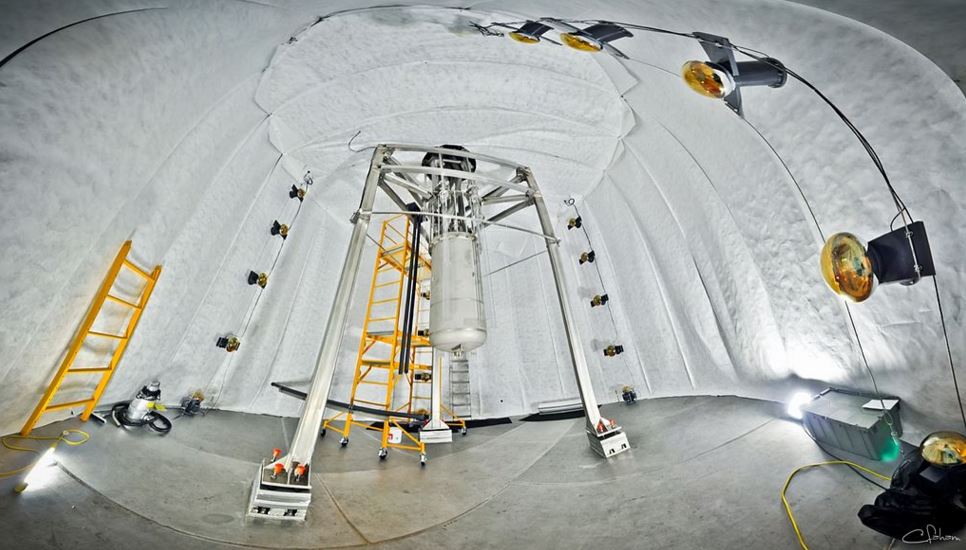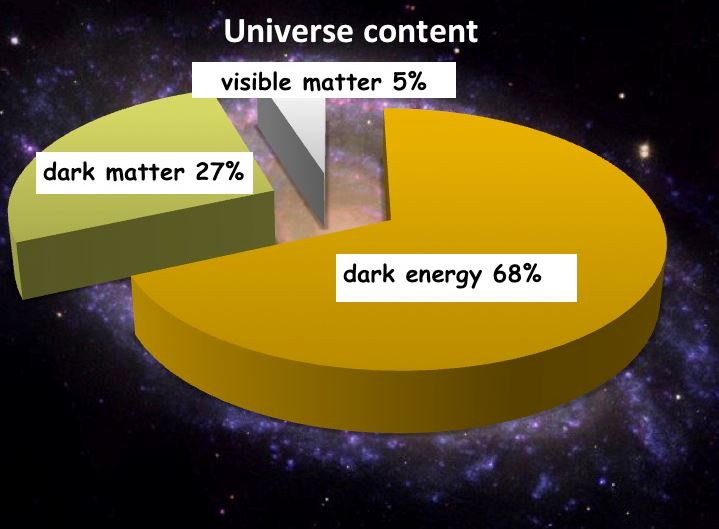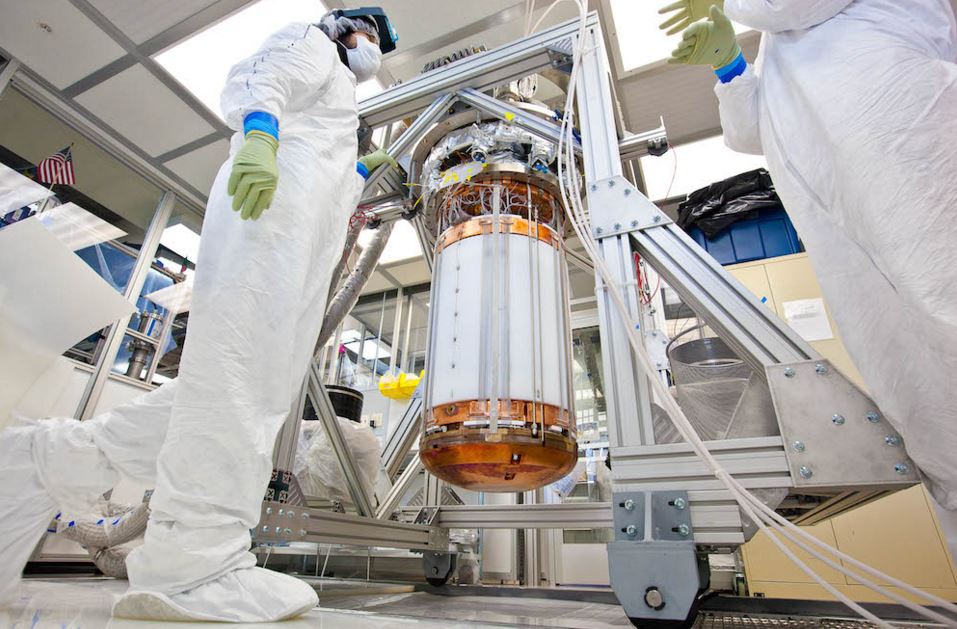A super sensitive dark matter detector, the Large Underground Xenon dark matter experiment, the most sensitive in the world, has just been improved. This means it is now even more sensitive than it was before. Next year, its larger replacement will be 100 times more sensitive than it is now.
Although we cannot see dark matter, we know it is there. Scientists say dark matter (along with dark energy) is the most common form of matter in the Universe. They are sure it exists because of the effects of its gravitational pull, which can be observed in the rotation of galaxies and the way light bends as it whizzes through the universe.
NASA says the following about Dark Matter and Dark Energy:
“It turns out that roughly 68% of the Universe is dark energy. Dark matter makes up about 27%. The rest – everything on Earth, everything ever observed with all of our instruments, all normal matter – adds up to less than 5% of the Universe.”
 The Large Underground Xenon (LUX) experiment installed 4,850 ft below ground inside a 70,000 gallon water tank shield. The experiment is a 370 kg liquid xenon time projection chamber that is designed to detect the faint interactions between WIMP dark matter and ordinary matter. (Image: Wikipedia)
The Large Underground Xenon (LUX) experiment installed 4,850 ft below ground inside a 70,000 gallon water tank shield. The experiment is a 370 kg liquid xenon time projection chamber that is designed to detect the faint interactions between WIMP dark matter and ordinary matter. (Image: Wikipedia)
Closer to finding dark matter
Even though astrophysicists have not yet found dark matter, scientists from 19 research universities and national laboratories in the US, the UK, and Portugal say we are one step closer, thanks to a large-scale physics experiments.
Scientists working on the Large Underground Xenon experiment (LUX) are trying to find weakly interacting massive particles (WIMPs), which are one of the leading candidates for dark matter.
WIMPs are believed to interact with matter we can see on very rare occasions, so they need to be detected directly.
LUX has not yet managed to detect a dark matter signal. However, its sensitivity has enabled researchers to all but rule out vast mass ranges where dark matter particles could exist.
In this new study, which has been submitted to Physical Review Letters and posted to AdXiv, scientists explain that LUX’ sensitivity for detecting low-mass dark matter particles is now over twenty times better than it was, i.e. its sensitivity has improved by more than a factor of twenty. This means it should be much better at finding WIMPs.
Dismissing red herrings
The scientists re-examined data gathered during LUX’s initial 3-month run in 2013, and helped dismiss the possibility of other detections of dark matter at low-mass ranges where previous experiments had reported potential detections.
LUX comprises ⅓ ton of liquid xenon surrounded with ultra-sensitive light detectors. It is designed to detect the very rare occasions when a particle of dark matter collides with a xenon atom within the detector.
 A view inside the LUX detector. Photomultiplier tubes can detect the tiniest bursts of lights when a particle interacts with xenon atoms. (Image: www.sanfordlab.org)
A view inside the LUX detector. Photomultiplier tubes can detect the tiniest bursts of lights when a particle interacts with xenon atoms. (Image: www.sanfordlab.org)
When a collision occurs, the xenon atom recoils and emits a tiny flash of light, which the LUX light sensors detect. The detector is below a mile of rock at Sanford Underground Research Facility (SURF), near Lead, South Dakota, USA. It’s location helps shield it from cosmic rays and other radiation that would interfere with dark matter signals.
Dr. Alastair Currie, who works at Imperial College London’s Department of Physics, who led the analysis of the results, said:
“We have looked for dark matter particles during the experiment’s first three-month run, but are exploiting new calibration techniques better pinning down how they would appear to our detector.”
“These calibrations have deepened our understanding of the response of xenon to dark matter, and to backgrounds. This allows us to search, with improved confidence, for particles that we hadn’t previously known would be visible to LUX.”
Playing pool with neutrons and xenon atoms
One calibration technique used neutrons as substitutes for dark matter particles. By bouncing neutrons off the xenon atoms, scientists can measure the LUX detector’s response to the recoiling process.
Professor Rick Gaitskell, who works at Brown University, Rhode Island, USA, said:
“It is like a giant game of pool with a neutron as the cue ball and the xenon atoms as the stripes and solids. We can track the neutron to deduce the details of the xenon recoil, and calibrate the response of LUX better than anything previously possible.”
 The part of the Universe we are able to see and detect directly makes up only about 5% of the total – the rest consists of dark matter and dark energy. (Image: www.quantumdiaries.org)
The part of the Universe we are able to see and detect directly makes up only about 5% of the total – the rest consists of dark matter and dark energy. (Image: www.quantumdiaries.org)
The nature of the interaction between xenon atoms and neutrons is believed to be similar to the interaction between xenon and dark matter.
Prof. Gaitskell said:
“It’s just that dark matter particles interact very much more weakly—about a million-million-million-million times more weakly.”
Scientists also used krypton
Krypton, another radioactive gas, was injected to help researchers distinguish between signals produced by ambient radioactivity and a potential dark matter signal.
Dan McKinsey, a UC Berkeley physics professor and co-spokesperson for LUX, said:
“The krypton mixes uniformly in the liquid xenon and emits radiation with a known, specific energy, but then quickly decays away to a stable, non-radioactive form. By precisely measuring the light and charge produced by this interaction, researchers can effectively filter out background events from their search.”
“And so the search continues. LUX is once again in dark matter detection mode at Sanford Lab. The latest run began in late 2014 and is expected to continue until June 2016. This run will represent an increase in exposure of more than four times compared to our previous 2013 run. We will be very excited to see if any dark matter particles have shown themselves in the new data.”
 The LUX dark matter detector is seen in this photo during the assembly process in a surface laboratory in South Dakota. (Image: Berkeley Lab. Credit: Matthew Kapust/Sanford Underground Research Facility)
The LUX dark matter detector is seen in this photo during the assembly process in a surface laboratory in South Dakota. (Image: Berkeley Lab. Credit: Matthew Kapust/Sanford Underground Research Facility)
LUX’s much larger cousin coming soon
LUX will be decommissioned in 2016, and will be replaced by a much bigger xenon detector – the LUX-ZEPLIN (LZ) experiment. LZ will have a 10-ton liquid xenon target, which will fit within the same 72,000-gallon tank of pure water that LUX uses.
Scientists say the LZ experiment will probably achieve more than 100 times LUX’s current sensitivity.
Dr. Henrique Araujo, who works at Imperial’s Department of Physics, is head of the UK’s contribution to LZ, which is funded by the Science and Technology Facilities Council.
Dr. Araujo said:
“The LUX calibration techniques which enable this result are very exciting also for LZ – making the next-generation experiment even better. It is also great to see this xenon-based technology, which was partly pioneered here at Imperial, continue to lead the way in the hunt for dark matter!”
Sanford Underground Research Facility
Scientists at the Sanford Underground Research Facility (Sanford Lab), where the LUX detector is located, go very deep underground in their attempt to answer some of the most challenging physics questions about the Universe, such as:
“What is the origin of matter? What is dark matter and how do we know it exists? What are the properties of neutrinos?”
Sanford lab is where a Homestake gold mine used to be, a physics landmark a long time before it was converted into a dedicated science facility.
American chemist, physicist, and Nobel Prize in Physics laureate, Ray Davis (1914-2006), first recognized the potential for deep science fifty years ago when he build his solar neutrino experiment at Homestake.
Citation: “Improved WIMP scattering limits from the LUX experiment,” LUX Collaboration: H. M. Araújo, X. Bai, A. J. Bailey, J. Balajthy, D. S. Akerib, P. Beltrame, E. P. Bernard, A. Bernstein, E. M. Boulton, A. Bradley, T. P. Biesiadzinski, R. Bramante, S. B. Cahn, M. C. Carmona-Benitez, C. Chan, J. J. Chapman, A. A. Chiller, C. Chiller, A. Currie, J. E. Cutter, T. J. R. Davison, L. de Viveiros, A. Dobi, J. E. Y. Dobson, E. Druszkiewicz, B. N. Edwards, C. H. Faham, S. Fiorucci, R. J. Gaitskell, V. M. Gehman, C. Ghag, K. R. Gibson, M. G. D. Gilchriese, C. R. Hall, M. Hanhardt, S. J. Haselschwardt, S. A. Hertel, D. P. Hogan, M. Horn, D. Q. Huang, C. M. Ignarra, M. Ihm, R. G. Jacobsen, W. Ji, K. Kazkaz, D. Khaitan, R. Knoche, N. A. Larsen, C. Lee, B. G. Lenardo, K. T. Lesko, A. Lindote, M. I. Lopes, D. C. Malling, A. Manalaysay, R. L. Mannino, M. F. Marzioni, et al. (plus 44 additional authors). Cornell University Library arXiv:1512.03506 [astro-ph.CO]. Submitted on 11 Dec 2015.
Video – Large Underground Xenon experiment
Deep in what used to be a gold mine in rural South Dakota, a team of scientists is hunting for astrophysical treasure. Their rare and elusive quarry is dark matter, a theoretical particle which has never been seen or detected directly. Yet its gravitational effect on distant galaxies suggests it exists and provides ample evidence to fuel the experiments and aspirations of scientists at the Sanford Underground Research Facility.

